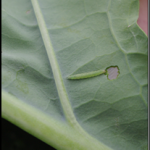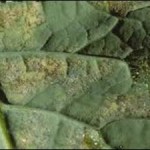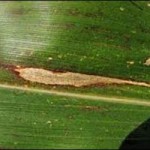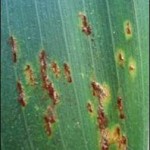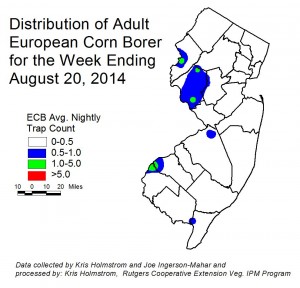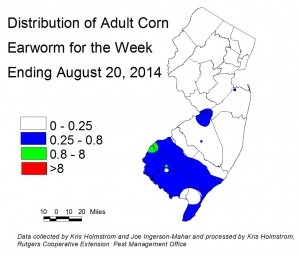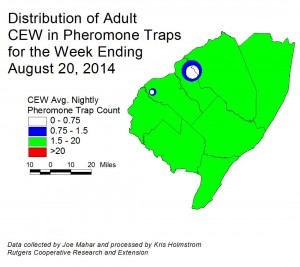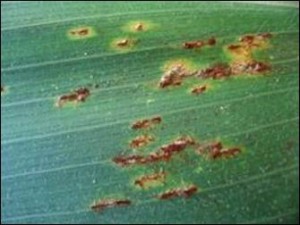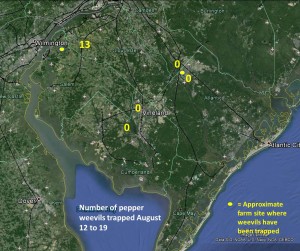There’s a lot going on this week!
Maps for the Week
–European Corn Borer Map
–Corn Earworm Moth Blacklight Trap Map
–Corn Earworm Moth Pheromone Trap Map
–Pepper Weevil Trap MapTopics for the Week
- Sweet Corn
- Peppers
- Tomatoes
- BMSB
- Pumpkins and Winter Squash
- Cole Crops
Vegetable IPM Report 8-20-14 – Click to View | Download | Print
Sweet Corn
European Corn Borer (ECB) adult activity remains concentrated in northern parts of the state (see ECB map). Overall activity is low. Whorl stage feeding is now interspersed with more dominant fall armyworm (FAW) feeding. As always, consider treating if 12% or more plants exhibit ECB feeding alone, or in combination with FAW (see below) injury. Remember to make a full-tassel application to control ECB larvae as they leave the tassel and travel down the stalk to re-enter the plant near the ear shank. This last application is often critical to controlling ear infestations from ECB.
| The highest nightly ECB catches for the previous week are as follows: | |||||
| Belvidere | 2 | Crosswicks | 1 | Little York | 1 |
| Pedricktown | 2 | Denville | 1 | Oldwick | 1 |
| Califon | 1 | Eldora | 1 | Sergeantsville | 1 |
| Clinton | 1 | Georgetown | 1 | South Branch | 1 |
Blacklight Trap Corn Earworm Moth (CEW): Corn earworm moths (CEW) catches did not increase significantly with the passing of last weeks’ low pressure system, although some of the southern pheromone traps registered sizeable catches (see the pheromone trap section below). Subsequent cool night temperatures further depressed catches. The weather is again becoming warmer and more humid in advance of low pressure coming from the west. Winds are forecast to come from the south east from Wednesday night through Thursday night. This may result in increased CEW activity in our area. Growers should be alert to the possibility that silk spray schedules may need to become more conservative before the end of the week. At present, the majority of CEW adult activity is along the Delaware Bay shore, including Cape May County (see CEW map), but there have been widely scattered catches as far north as Morris County. Overall, CEW has been light this year, and the extent of the late population remains to be seen. Catches in Virginia have increased, although not significantly. Delaware catches are similar to our southern NJ catches. A prolonged southerly wind may cause this situation to change for the worse.
| The highest nightly CEW trap catches are as follows: | |||||
| Pedricktown | 2 | Downer | 1 | Green Creek | 1 |
| Allentown | 1 | East Vineland | 1 | Jones Island | 1 |
| Centerton | 1 | Folsom | 1 | Tabernacle | 1 |
| Cinnaminson | 1 | Georgetown | 1 | Woodstown | 1 |
Pheromone Trap Corn Earworm Moth (CEW): CEW pheromone trap catches have increased, particularly along the Delaware Bay shore (see CEW pheromone trap map . While these catches are not what we would expect with a large scale migration event, they are significantly higher in some areas than they were a week ago. The green area on the map roughly corresponds to a 4-day silk spray schedule. Low spots within the broader green area should be considered outliers, and grower near those areas should defer to the more conservative schedule. Sweet corn plantings now in silk in southern NJ are at risk for ear infestation if CEW is not properly controlled. As silks begin to appear, pay close attention to CEW catches in local blacklight traps, and treat silking plantings accordingly.
| The highest nightly CEW pheromone trap catches are as follows: | |||||
| Green Creek | 88 | Eldora | 9 | Indian Mills | 6 |
| Elm | 10 | Pedricktown | 9 | Woodstown | 6 |
Silking Spray Schedules*:
South – 3-4 days
Central – 4-5 days
North – 5 days
*Note: These are general recommendations. Local trap catches may indicate some variation in the frequency of insecticide applications to silking corn.
Fall armyworm (FAW) infestations remain common, and are occurring in very young plantings. Infestations of whorl and even seedling stage corn are occurring as far north and west as Warren and Sussex counties. It is important that all plantings be scouted regularly for this pest. FAW caterpillars consume corn foliage, and produce large quantities of feces that pile up within the whorl. FAW larvae typically have light and dark brown bands, and the head capsule has a distinctive upside-down “Y” pattern on it. Unlike ECB, FAW will feed on corn plantings in the seedling stage, although whorl stage is usually the first to be affected. Consider treating if the number of plants infested with FAW either alone, or in combination with ECB exceeds 12%. FAW may be difficult to control with pyrethroid insecticides. Newer materials, including spinosad-based insecticides, as well as those including active ingredients chlorantraniliprole and flubendiamide are effective against BAW.
Foliar Diseases of Sweet Corn are increasingly common now. These include corn leaf rust (CR) and northern corn leaf blight (NCLB). As nights become longer and cooler through late summer, dew deposition will increase. These factors favor foliar disease. Both CR and NCLB can negatively impact ear development if they become heavy on foliage. CR causes ruptures in the leaf surface, resulting in moisture loss that stresses the plant. NCLB reduces the amount of photosynthetic surface available to the plant. Both are more serious the earlier they develop on corn plants. Generally, if the first signs of disease occur after the pre-tassel stage, damage will likely be confined to cosmetic blemishes on the husk. If infections first appear in the whorl stage, the possibility exists for ear size to be reduced as the plants struggle to compensate for water loss and reduced leaf surface. Consult the 2014 Commercial Vegetable Production Recommendations for specific fungicide recommendations, but be aware that the strobilurin class (FRAC Grp. 11) has provided poor results on NCLB in the northern parts of the state.
Peppers
With ECB moths emerging in many areas, treatments may become necessary to prevent infestations. As ECB warrants control (local blacklight catches at 1/night), consider an insecticide that is not destructive to predators and parasites of aphids and TSSM. These include Coragen and Belt (or Synapse).
Beet armyworm (BAW) have been captured in southern counties. Most traps are catching just a few moths, but recently traps in the Woodstown area have averaged nearly 15/night for the past week. BAW larvae will feed on leaves near the growing terminals of the plants, resulting in shredded foliage at the top. As the larvae molt and grow larger, they will begin feeding on fruit. BAW, like FAW is difficult to manage with pyrethroid insecticides. Materials that are recommended for FAW control (see the FAW paragraph above), will also be effective against BAW.
Pepper Weevil Report. Trap counts at one processing facility have increased to the highest level since early June. The intermittent catch of weevils in the trap further suggests that a field was infested early in the season, and as peppers were brought in from that field to the processor, another batch of weevils are released.
If possible, farmers should power wash/steam clean produce bins exchanged with produce handlers before taking them to the field to avoid field infestations developing.
No new field infestations have been reported since last week.
Tomatoes
Native brown stinkbugs are still causing damage in tomatoes. Typically, injury increases with drier weather. Be sure to monitor fruit for this damage. If adults are found in more than one sample, or if nymph groups are found, or injury is increasing in harvested fruit, consider an insecticide application to limit further damage. Consult the 2014 Commercial Vegetable Production Recommendations for specific insecticide recommendations.
Two-spotted spider mite (TSSM) populations have become more common in tomatoes as drier weather dominated the past several weeks. Initially, this pest may go unnoticed. As numbers increase, foliage will become yellow, and ultimately turn brown and dry. At this point, TSSM webbing will be obvious, connecting leaves so that mites can move about the plant to less populated areas. TSSM is best managed while still at low levels. Look for the mite “stipple” (whitish pin-spots), indicating a low level population under the affected leaf. If this sign of infestation is present in multiple sites within the field, consider applying one of the newer miticides. There are a number of effective materials that have very short pre-harvest intervals. Consult the 2014 Commercial Vegetable Production Recommendations for specific insecticide recommendations.
Brown Marmorated Stinkbug (BMSB)
BMSB activity is extremely low. At present, no traps are catching more than one per night. Adult activity continues to be well behind previous years. As adult captures increase to 5/night for a full week, maps will be produced to show where activity is highest. Information on scouting, crop injury and control will also be included.
Pumpkins and Winter Squash
Cucurbit downy mildew (CDM) has been detected on cucumbers at the Snyder Research and Extension Farm in Pittstown, Hunterdon County as of Monday. Another cucumber planting near Princeton was also found to be infected. At this time, no other cucurbit crops appear to be impacted in these areas. However, given the virulence of CDM, it is advisable that pumpkin growers begin to add fungicides that specifically target CDM to their regular protectant program for powdery mildew (PM).
Powdery mildew (PM) thresholds have been reached in all fields in northern and central NJ. The same is undoubtedly the case in southern NJ as well. Check upper and lower surfaces of 2 mature leaves per plant on 5 consecutive plants each, in 10 locations throughout the field. When PM lesions are found on 2 or more leaves, begin a weekly protectant fungicide program. See the 2014 Commercial Vegetable Production Recommendations for materials useful in managing CDM and PM.
The CDM website http://cdm.ipmpipe.org/ asserts that known infection sites in the eastern US, will likely spread east or northeast, consistent with prevailing breezes. This website should be a “favorite” on every grower’s web browser. It is advisable that all growers scout crops at least twice a week. Any further occurrence will be reported in this newsletter and will also generate an alert to all subscribers.
Cole Crops
Many of the fall plantings have been or are becoming established now. Cabbage looper (CL) infestations are fairly common, as well as diamondback moth (DBM), imported cabbage worm (ICW). Scout plantings weekly. Check 5 consecutive plants each in 10 random locations throughout the planting, paying particular attention to the innermost leaves where ICW often feed. Consider treating if caterpillars are found on 10% or more plants that are in the 0-9 true leaf stage. From 9-leaf to the early head stage (in broccoli, cauliflower and cabbage) infestations up to 20% may be tolerated. Once heads begin to form, a 5% threshold should be observed to protect the marketable portion of the plant. For leafy greens such as collards and kale, 10% plants infested is the threshold throughout. It is important to identify DBM correctly, because if it present, synthetic pyrethroid insecticides may not provide acceptable control. DBM larvae are small, and taper toward both ends. They thrash vigorously when disturbed (see photograph at right).
In parts of central NJ, new broccoli and collard plantings are developing crucifer downy mildew (CrDM) infections. CrDM caused necrotic spots to develop on the upper surface of older leaves. Inspection of the lower leaf surfaces will show pale purple sporulation (see photo at right) erupting from the infected tissue. This disease can be especially hard on broccoli and collard greens, so growers should actively scout plantings at least weekly. Cole crops should be treated with appropriate fungicides at the first occurrence of this disease. Consult the 2014 Commercial Vegetable Production Recommendations for specific fungicide recommendations.
All current and archived Vegetable IPM Maps including European corn borer, corn earworm and brown marmorated stink bug population maps are available for viewing @ http://tinyurl.com/njaes-ipm-maps
